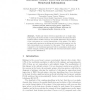Free Online Productivity Tools
i2Speak
i2Symbol
i2OCR
iTex2Img
iWeb2Print
iWeb2Shot
i2Type
iPdf2Split
iPdf2Merge
i2Bopomofo
i2Arabic
i2Style
i2Image
i2PDF
iLatex2Rtf
Sci2ools
ICANN
2011
Springer
2011
Springer
Automatic Seizure Detection Incorporating Structural Information
Abstract. Traditional seizure detection algorithms act on single channels ignoring the synchronously recorded, inherently interdependent multichannel nature of EEG. However, the spatial distribution and evolution of the ictal pattern is a crucial characteristic of the seizure. Two different approaches aiming at including such structural information into the data representation are presented in this paper. Their performance is compared to the traditional approach both in a simulation study and a real-life example, showing that spatial and structural information facilitates precise classification.
| Added | 29 Aug 2011 |
| Updated | 29 Aug 2011 |
| Type | Journal |
| Year | 2011 |
| Where | ICANN |
| Authors | Borbala Hunyadi, Maarten De Vos, Marco Signoretto, Johan A. K. Suykens, Wim Van Paesschen, Sabine Van Huffel |
Comments (0)

